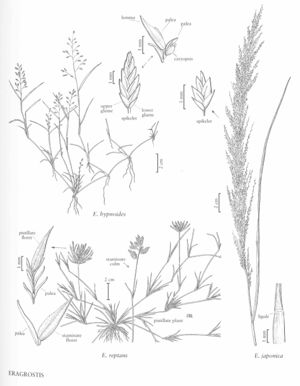Difference between revisions of "Eragrostis reptans"
FNA>Volume Importer |
imported>Volume Importer |
||
| (7 intermediate revisions by 2 users not shown) | |||
| Line 7: | Line 7: | ||
|synonyms={{Treatment/ID/Synonym | |synonyms={{Treatment/ID/Synonym | ||
|name=Neeragrostis reptans | |name=Neeragrostis reptans | ||
| − | |authority= | + | |authority= |
| + | |rank=species | ||
}} | }} | ||
|hierarchy=Poaceae;Poaceae subfam. Chloridoideae;Poaceae tribe Cynodonteae;Eragrostis;Eragrostis reptans | |hierarchy=Poaceae;Poaceae subfam. Chloridoideae;Poaceae tribe Cynodonteae;Eragrostis;Eragrostis reptans | ||
| Line 28: | Line 29: | ||
-->{{#Taxon: | -->{{#Taxon: | ||
name=Eragrostis reptans | name=Eragrostis reptans | ||
| − | |||
|authority=(Michx.) Nees | |authority=(Michx.) Nees | ||
|rank=species | |rank=species | ||
| Line 35: | Line 35: | ||
|basionyms= | |basionyms= | ||
|family=Poaceae | |family=Poaceae | ||
| + | |illustrator=Linda A. Vorobik;Cindy Roché | ||
| + | |illustration copyright=Utah State University | ||
|reference=None | |reference=None | ||
|publication title= | |publication title= | ||
|publication year= | |publication year= | ||
|special status= | |special status= | ||
| − | |source xml=https:// | + | |source xml=https://bitbucket.org/aafc-mbb/fna-data-curation/src/200273ad09963decb8fc72550212de541d86569d/coarse_grained_fna_xml/V25/V25_112.xml |
|subfamily=Poaceae subfam. Chloridoideae | |subfamily=Poaceae subfam. Chloridoideae | ||
|tribe=Poaceae tribe Cynodonteae | |tribe=Poaceae tribe Cynodonteae | ||
Latest revision as of 17:55, 11 May 2021
Plants annual; unisexual, pistillate and staminate plants morphologically similar; mat-forming, without innovations, without glands. Culms rooting at the lower nodes, erect portion 5-20 cm, glabrous, pilose, or villous, particularly below the panicles. Sheaths mostly scabrous, margins sometimes with 0.1-0.4 mm hairs; ligules 0.1-0.6 mm; blades 1-4 cm long, 1-4.5 mm wide, flat or conduplicate, abaxial surfaces glabrous, adaxial surfaces appressed pubescent, hairs about 0.2 mm. Panicles terminal, 1-3 cm long, 0.6-2.5 cm wide, ovate, contracted, exerted or partially included in the upper leaf sheaths, rachises somewhat viscid, pilose or glabrous; primary branches 0.5-1.5 cm, appressed to the rachises, each terminating in a spikelet; pulvini sparsely pilose or glabrous; pedicels 0.2-2 mm, shorter than the spikelets, glabrous or hairy. Spikelets 5-26 mm long, 1.5-4.7 mm wide, linear to ovate, greenish to stramineous, with 16-60 florets; disarticulation in the pistillate florets basipetal, the lemmas falling separately, staminate spikelets not or tardily disarticulating. Glumes unequal, ovate, hyaline, glabrous or sparsely hirsute; lower glumes 0.8-1.6 mm, 1-veined; upper glumes 1.5-2.5 mm, 1-3-veined; lemmas (1.5)1.8-4 mm, ovate, hyaline to membranous, lateral veins conspicuous, greenish, apices acute to acuminate, sometimes prolonged into a mucro, mucros to 0.4 mm; paleas 0.7-3.8 mm, hyaline, about 1/2 as long as the lemmas in pistillate florets, as long as the lemmas in staminate florets, keels scabridulous; anthers 3, 1.4-2.2 mm, reddish to yellowish. Caryopses 0.4-0.6 mm, ellipsoid, somewhat laterally compressed, smooth, light reddish-brown. 2n = 60.
Discussion
Eragrostis reptans grows in wet sand, gravel, and clay soils along rivers and lake margins from the United States to northern Mexico, at 0-400 m, frequently with Cynodon dactylon and Heliotropium. It flowers from April through November.
Selected References
None.
